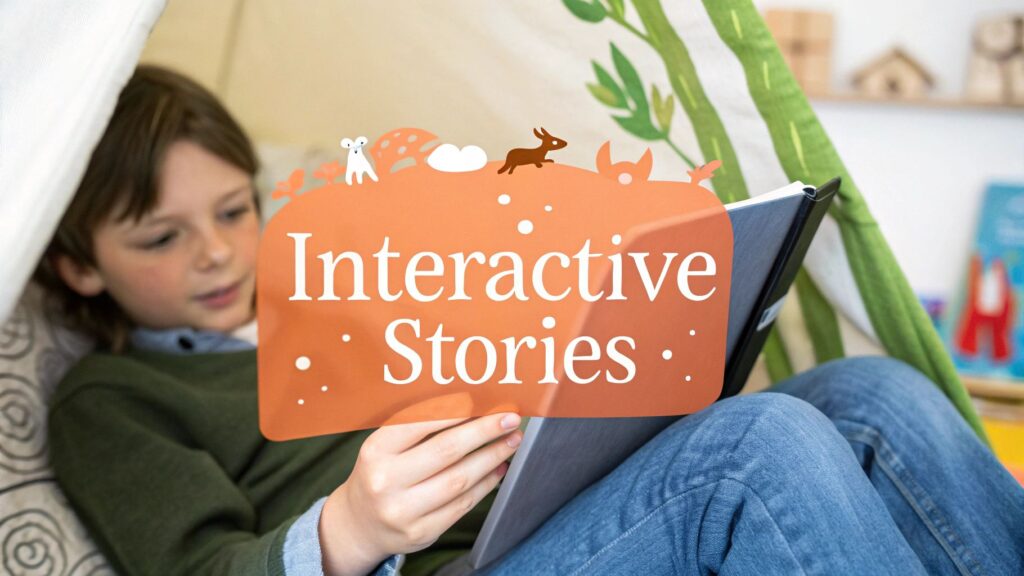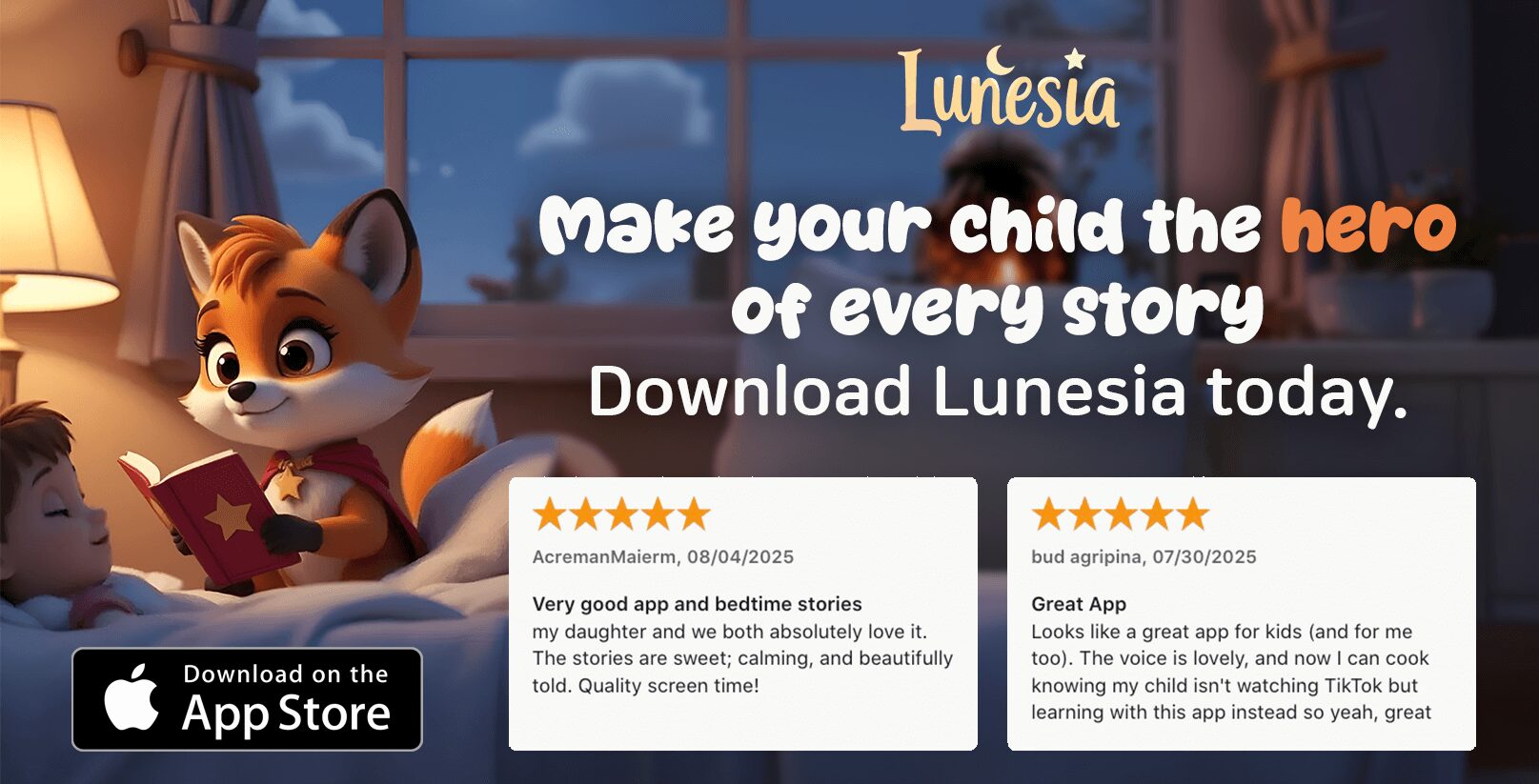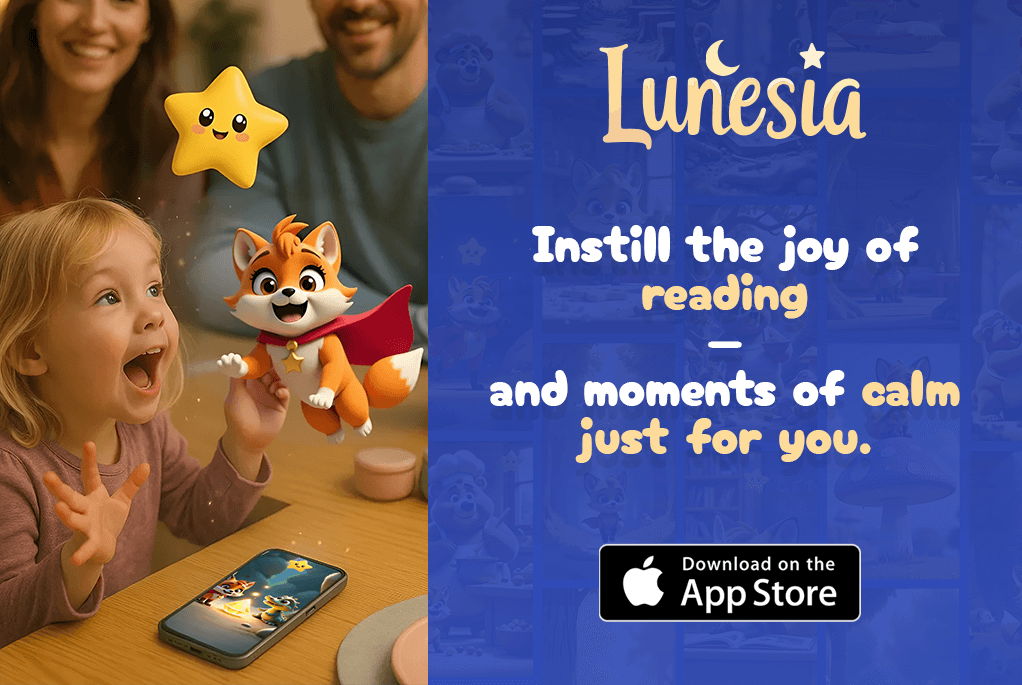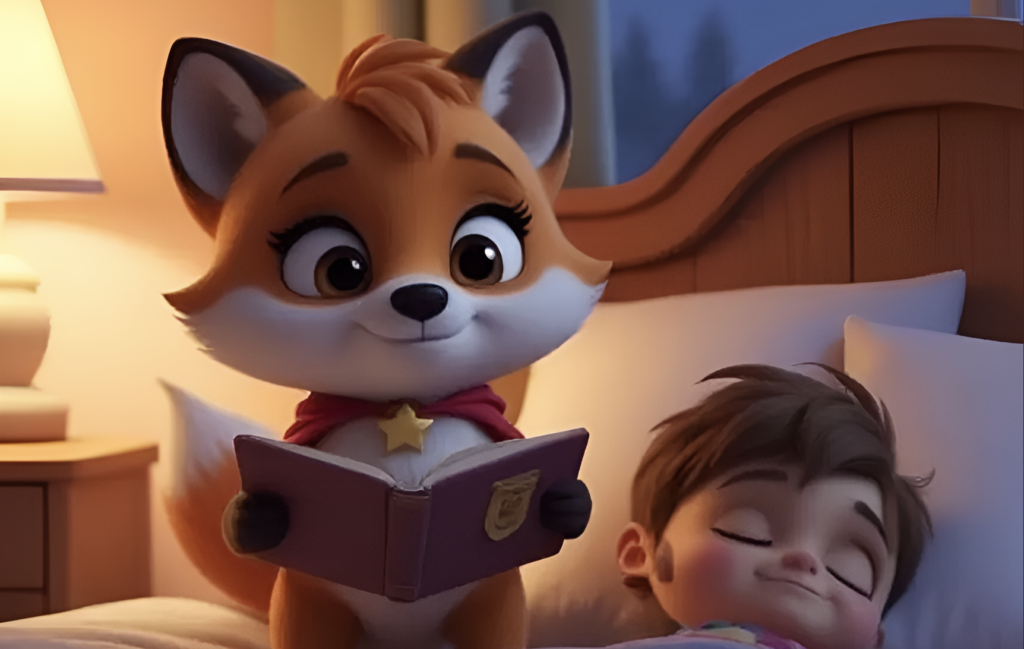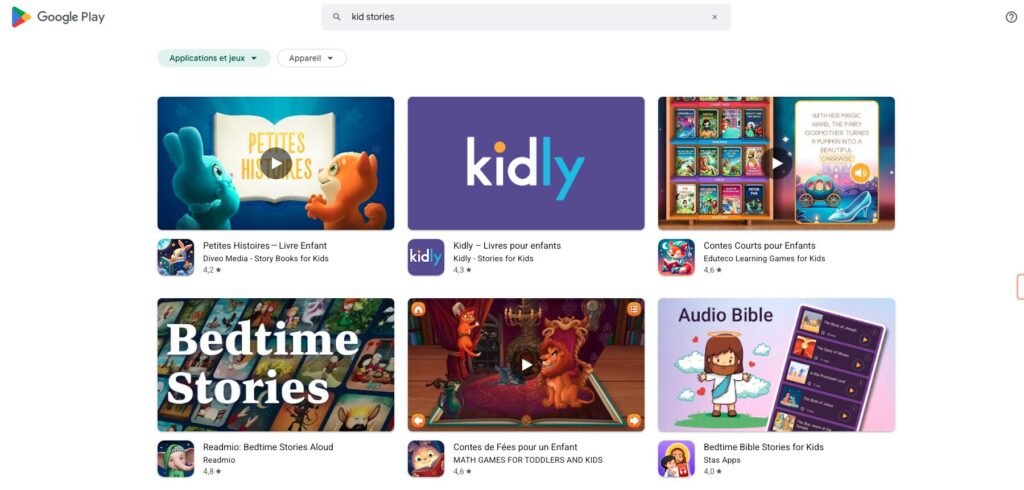Ever hand your child a tablet and feel that little twinge of guilt? You’re not alone. But what if that screen time could be transformed from a moment of worry into a powerful tool for growth? What if, instead of just watching a story, your child could shape it?
There’s a world of difference between passively watching a cartoon and actively leading an adventure. That difference is where the real magic happens for children aged 2 to 7.
Rethinking Your Child's Screen Time
We all grapple with the screen time dilemma, but the conversation is finally shifting from how much to what kind. Are you wondering if there's a better way to handle those moments when you need a little break? There is.
Imagine your child isn’t just watching a character on an adventure—they are the character. They get to decide if the lonely dragon gets a friend or if the lost puppy finds its way home. This is the incredible power of high-quality interactive stories for kids.
From Passive Viewing to Active Engagement
Ever notice how your child’s eyes glaze over during a cartoon? That's passive viewing. But what happens when they're invited to become a co-creator in the story? Their whole mind lights up. This simple shift from a passive audience member to an active participant is a total game-changer for early development. In fact, research shows that active engagement during screen time leads to far better cognitive outcomes.
When your child makes a choice in a story, they're not just tapping a screen. They're flexing their decision-making muscles, practicing empathy, and learning that their actions have consequences—all within a safe, imaginative space.
This is the very heart of what we do at Lunesia. We believe screen time can and should be meaningful. Our stories aren't just entertainment; they’re value-rich journeys that teach kindness, courage, and problem-solving. While your child is immersed in a safe, ad-free adventure, you get a precious moment for yourself—completely guilt-free.
Curious about the real difference? This table breaks it down.
Passive Viewing vs Interactive Storytelling
| Feature | Passive Screen Time (e.g., Cartoons) | Interactive Stories (e.g., Lunesia) |
|---|---|---|
| Child's Role | Observer | Participant, Decision-maker |
| Cognitive Skill | Follows a linear plot | Develops critical thinking, problem-solving |
| Emotional Skill | Observes emotions | Practices empathy by making choices |
| Outcome | Fixed and unchangeable | Varies based on child's decisions |
| Core Lesson | The story happens to them | Their actions shape the story |
It’s clear, isn’t it? When a child gets to steer the narrative, their brain is firing on all cylinders. They aren't just consuming content; they're creating an experience.
Take a look at this chart—it shows just how much interactive stories can boost engagement and vocabulary compared to even traditional books.
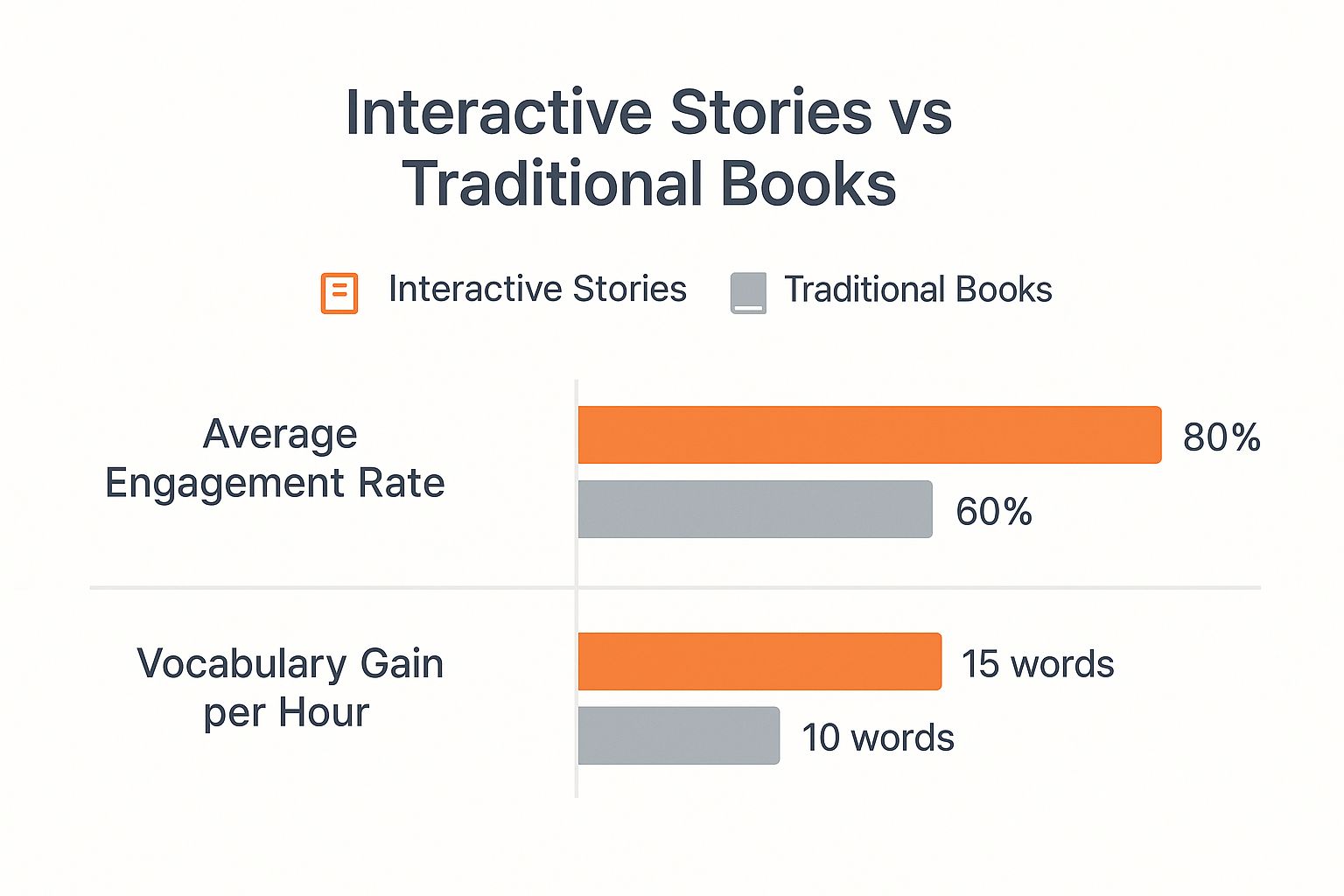
The data really speaks for itself. Active participation not only holds a child's attention longer but also helps accelerate their language development in a way that passive viewing just can't match.
How Stories Become Adventures

Remember those ‘choose-your-own-adventure’ books? The thrill of flipping to page 42 to see if you discovered treasure or walked into a trap? Today’s interactive stories for kids are the supercharged evolution of that idea, designed with a much deeper purpose.
So, what’s the secret sauce that turns a simple tale into a genuine adventure? It’s the power of choice. When your child steps into the main character's shoes, they’re no longer just an audience member; they’re the director of their own journey.
This shift from listener to leader is a huge deal. When your child decides if a little squirrel should share its nuts or save them for winter, they're exploring real-world concepts like generosity and planning. They see the direct results of their actions in a safe, imaginative space. That's a lesson no lecture can teach.
From Listening to Leading the Way
This is where the real learning magic happens. Every decision point in an interactive story is a gentle lesson in cause and effect. Think of it as a sandbox for life, a place where children can practice kindness, bravery, and problem-solving without any real-world risks.
In Lunesia’s interactive adventures, we don’t just tell stories about courage—we create scenarios where your child gets to be courageous. They help a shy firefly find its glow or guide a lost bear back to its family, building emotional resilience with every choice they make.
These aren't just whimsical tales; they are carefully crafted to address the real challenges of childhood. By navigating these stories, children learn how to handle their own big feelings, like anxiety or frustration, in a healthy, constructive way. You can explore more about the profound benefits of interactive storytelling for preschoolers in our detailed guide.
The Growing Movement Toward Interactive Learning
Are parents and educators catching on? Absolutely. The global interactive children's books market, valued at around USD 3.4 billion, is projected to nearly double by 2033. This incredible growth isn't just a trend; it's fueled by a wider understanding of how these experiences boost literacy, cognitive skills, and emotional intelligence.
At the end of the day, interactive stories give children agency. They learn that their voice matters and that their choices have the power to create a positive outcome. If you're curious about the mechanics, you can even learn how to create a 'choose your adventure' story with video. That simple mechanic—the choice—is what elevates a story from something you just hear into something you live.
The Brain-Building Power of Making Choices
What’s really happening inside your child’s head when they decide if a character should share a magical berry or keep it? It’s so much more than a simple tap. Think of each choice as a workout for their developing mind, strengthening the crucial pathways needed for complex thinking.
This is the brain-building magic behind interactive stories for kids. When your child makes a decision, they’re actively firing up their executive functions—the brain’s air traffic control system that manages planning, focus, and self-control. These are the same skills they’ll use for everything from tying their shoes to navigating playground politics.
Turning Feelings into Strengths
Have you ever watched your little one get completely overwhelmed by a big feeling? A tantrum over a puzzle piece that won’t fit, or a sudden fear of a shadow on the wall? Interactive stories create a safe, imaginative sandbox for them to practice navigating these exact emotions.
Imagine a story where a bunny is scared of the dark. When your child chooses to help the bunny find a nightlight or sing a brave song, they aren't just pushing the plot forward. They are learning, by doing, that scary feelings can be managed and that they have the power to be courageous.
The Lunesia app is packed with these moments. Our stories are intentionally designed to help children build emotional resilience. By guiding characters through challenges, they learn to recognize and name their own feelings, turning wobbly moments of uncertainty into opportunities for growth.
When a character in a Lunesia story gets upset because their sandcastle gets knocked over, your child can choose how to respond. Should they help rebuild it? Offer a hug? Each option teaches a different, valuable lesson in empathy and problem-solving. It's a hands-on way to understand that it’s okay to feel sad or angry, but it’s what you do with that feeling that really counts.
From Story Choices to Real-World Skills
The best part? These benefits don't just stay inside the app. The skills your child practices translate directly into their everyday life. Studies show that making choices and seeing the immediate consequences helps children develop a much stronger sense of cause and effect.
Here’s how in-story choices build real-world skills:
- Problem-Solving: Helping a character cross a tricky river is great practice for figuring out how to get that toy that rolled under the couch.
- Empathy: Deciding to be kind to a grumpy troll in a story teaches them to consider a friend's feelings when they're having a bad day.
- Confidence: Every successfully navigated adventure builds their self-esteem and shows them that their decisions matter.
This whole process transforms your child from a passive listener into an active, empowered thinker. To see even more examples of this in action, check out our guide on how interactive stories boost problem-solving skills. Through these rich journeys, your child isn't just being entertained—they're building the foundation for a kind, resilient, and resourceful life.
How to Choose the Right Interactive Stories

With a sea of apps out there, how do you find the hidden gems that actually nurture your child’s growing mind? Let's be honest, not all interactive stories for kids are created equal.
Some are just tap-and-play games offering a few minutes of distraction. But the best ones? They offer rich, branching narratives that genuinely foster growth. The key is learning to tell the difference between fleeting entertainment and a valuable tool that aligns with your family’s values.
Look for Age-Appropriate Challenges
The best interactive stories meet your child exactly where they are. A story for a two-year-old might focus on simple colors and sounds, while a five-year-old is ready to tackle simple moral dilemmas.
This is why the entire Lunesia library is crafted with child development experts. Our stories grow with your child, presenting challenges that are stimulating but never overwhelming. It’s all about building their confidence, one successful decision at a time.
Prioritize Positive Values and Safety
Beyond the fun plot, what lessons are the stories really teaching? Look for narratives that model kindness, empathy, and courage. It also helps to find stories with well-designed characters, as strong character design fundamentals are what help children form an emotional connection and stay engaged.
Just as important is the digital environment itself. A truly safe space for kids should be completely ad-free. This isn’t just about avoiding accidental purchases; it's about protecting your child from distracting and often inappropriate commercial content.
Choosing the right interactive story means you're not just picking a game—you're selecting a partner in your child's emotional and cognitive development. It’s an investment in their ability to think critically and act with kindness.
Your Quick Checklist for a Great Story
When you’re exploring new options, keep these key points in mind. A quality app should tick every single box:
- Meaningful Choices: Do the child’s decisions actually change the story’s outcome, or are they just for show?
- Value-Driven Content: Do the stories model positive behaviors like sharing, perseverance, and helping others?
- Completely Ad-Free: Is the experience free from interruptions, pop-ups, or third-party advertisements?
- Emotional Depth: Does the story help children understand and navigate big feelings like frustration, sadness, or fear?
Apps like Lunesia are built on these exact principles, making sure your child isn't just entertained, but genuinely nurtured. If you're looking for recommendations, our guide on the best free storytelling apps for kids is a great place to start your search.
Your Guide to Guilt-Free Screen Time
Let’s be real for a moment. Parenting is a marathon. Sometimes you just need five minutes to throw dinner together or sip your coffee while it’s still hot. But the moment you hand over a tablet, the guilt creeps in, doesn't it?
What if you could reclaim those moments, completely guilt-free? This is where high-quality interactive stories for kids stop being a distraction and start being your secret weapon. It’s not about finding a digital babysitter; it’s about choosing an experience that’s constructive, safe, and genuinely enriching.
From Occupied to Engaged
When your child opens a Lunesia adventure, they aren’t just “occupied.” They’re stepping into a world where they are the hero, making choices that quietly build real-life skills. They are actively learning, exploring big emotions, and stretching their imagination in a completely safe, ad-free space.
This simple shift transforms screen time from a passive activity into an active learning session. Instead of worrying about what they’re watching, you can feel genuine peace of mind, knowing your child is engaged in something truly beneficial. It’s about replacing that nagging parental guilt with confidence.
While your child is busy helping a lost star find its way back to the sky, you get that precious window of time back for yourself. You can recharge, knowing they are not just safe—they are growing.
Think of it as a true win-win. Your child gets a meaningful, brain-building adventure, and you get that much-needed moment of calm. This isn’t just screen time; it’s smart screen time.
Here’s what that guilt-free time really looks like:
- Your child learns empathy by deciding whether to help a sad, little cloud.
- They build resilience by navigating a story’s tricky challenges and trying again.
- You get to finish your thought while they practice their problem-solving skills.
The end result? A happier, more balanced family dynamic where technology serves as a tool for both growth and well-being.
Bringing Stories into Your Daily Routine
The real magic of interactive stories for kids happens when they slide right into the moments you already share. You don't need a huge chunk of time; think of those tricky transitions—like before dinner, after a bath, or during a long car ride.
With Lunesia’s library of over fifty animated tales, a new journey is just a few taps away. Imagine your three-year-old's face lighting up as they choose their own name and guide a character through a challenge. It gives them a real sense of ownership and control.
For example, a quick problem-solving story can be the perfect bridge from chaotic playtime to cleanup time. As your child helps a snail find its shell, they’re practicing patience and responsibility without even realizing it. That’s far more effective than just telling them to put their toys away!
- Use 5 minutes before lunch for a story that calms the pre-meal wiggles.
- Turn a gentle tale into a wind-down cue for naptime or bedtime.
- When sibling squabbles erupt, pick a kindness adventure to model sharing and empathy.
Timing Tips for Busy Days
Short, interactive sessions can add structure to the day without feeling like another task on your to-do list. Here’s how you can easily slot them in:
- The "5 More Minutes" Stall: Instead of a battle, offer a quick story to ease the transition out the door.
- After-School Decompression: Choose a courage tale to help with separation anxiety or post-school jitters.
- The Bedtime Wind-Down: End the day with a gentle narrative in a completely safe, ad-free space.
“I love seeing my child light up when they steer the story,” says one parent. This really gets to the heart of it—simple routines can lead to big emotional growth.

Learning really clicks when you connect the choices in the story to real life. When a character shares their toys, you can follow up with a chat about sharing at the park later.
Each story is built around choices that mirror everyday challenges, which means the lessons actually stick. You'll start to see the results in their behavior and confidence.
Turning Choices into Conversations
Think of the in-app decisions as conversation starters. After your child helps a character get over a fear of the dark, you can ask:
- "That was so brave! What helps you feel brave when you're a little scared?"
- "Why do you think the little bear was happy when you shared the berry?"
By weaving these stories into your day, interactive storytelling stops being just "screen time." It becomes quality time for bonding and growth.
The global interactive children's books market is growing for a reason—parents are seeing the value in personalized experiences that build engagement and a sense of ownership. You can find more insights on this trend on expertmarketresearch.com.
With Lunesia in your toolkit, routine moments become opportunities to teach kindness, problem-solving, and empathy. And while your child is happily absorbed in an adventure, you get a few precious, guilt-free minutes to yourself. Coffee in hand, peace of mind intact.
Small, consistent habits really do yield big rewards.
Got Questions? Let's Talk.
If you’re new to interactive stories for kids, it’s natural to have a few questions. We all want to make the best choices for our little ones, and that starts with feeling confident. So, let’s grab a virtual coffee and chat through some of the things that might be on your mind.
You’re probably wondering, "What’s the right age to start something like this?" or maybe, "How does this fit in with the physical books we love so much?" These are great questions—the kind every thoughtful parent asks. And thankfully, the answers are refreshingly simple.
Is My Child Ready for Interactive Stories?
Have you seen your two-year-old pointing at pictures in a book, trying to poke the characters or turn the page all by themselves? That’s your sign! They're already exploring cause and effect, and that’s the perfect entry point for simple interactive stories.
A good app meets them right where they are. For the littlest ones, it might be as simple as choosing an animal to hear its sound. As they grow, say around ages four to seven, the stories can grow with them. In Lunesia, for instance, the choices become more about emotions—like helping a character learn to share or find their courage. The key is to match the story's challenge to their stage of development, so it feels empowering, not frustrating.
How Do Interactive Stories and "Real" Books Work Together?
I get this one a lot. The best way to think about it is that interactive stories and physical books aren’t rivals; they’re teammates. Each one brings something different to the table, and both are incredibly valuable.
Snuggling up with a well-loved picture book builds that irreplaceable bond and a deep-seated love for reading. Interactive stories, on the other hand, are like a playground for practicing decision-making, empathy, and resilience in a dynamic, engaging way.
An interactive story doesn't replace the cherished ritual of bedtime reading; it adds to it. You could start with a Lunesia adventure to help wind down the day’s energy, then follow it up with a favorite book to cuddle with. You truly get the best of both worlds.
Is an App Like Lunesia Genuinely Safe?
This is, without a doubt, the most important question. As a parent, your child’s safety is everything. A high-quality story app absolutely must be a completely closed, ad-free environment. Period.
With an app like Lunesia, you never have to worry about a random ad, a third-party link, or inappropriate content popping up and derailing the experience. It’s a walled garden, built from the ground up just for your child's growth and enjoyment. That peace of mind is non-negotiable.
Ready to turn screen time into a meaningful, guilt-free adventure? With Lunesia, your child can become the hero of their own story, learning kindness, courage, and problem-solving with every choice they make. Download Lunesia today and start your free trial
